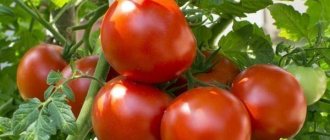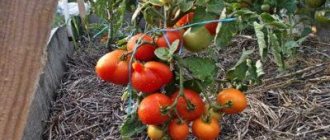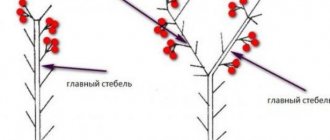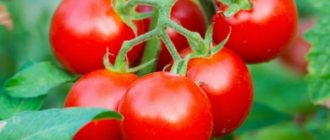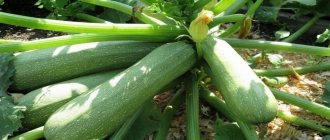Description of the Gypsy tomato
The Gypsy tomato was officially registered in 2000. The main advantage of this variety is that it can be purchased at any garden store.
The Gypsy tomato belongs to the determinate varieties of tomatoes of medium ripeness. Plant height is from 85 to 125 cm. The bushes are neat, not spreading, with green leaves of a regular shape. From the emergence of seedlings to the harvest period, only 110 days pass. Gypsy tomatoes are very heat-loving, grow well in greenhouse conditions; the crop is planted in an open garden bed only in the south.
The trusses of the Gypsy tomato are formed after every 3rd leaf. The ovary begins to form above the 8th leaf. Each cluster can ripen 4-5 tomatoes.
Description of fruits
The shape of Gypsy tomatoes is rounded and aligned and looks neat on the branches. The weight of one fruit is from 100 to 170 g. When fully ripe, tomatoes have a chocolate color with a slight pinkish tint. The tomato pulp is very sweet, juicy, and has a slight sourness.
Brief information about the variety
- Fruits and bush : medium-sized tomatoes, the weight of one copy is 120 g, the color is chocolate brown, with a pink tint; determinate bush, medium leafy, height – 70-120 cm.
- Productivity : the Gypsy variety is high-yielding (4-5 kg of fruits are collected from one bush).
- Resistance : the plant is moderately resistant to diseases and pests, requires preventive treatments.
- Distribution : when grown in greenhouse conditions, the variety can be cultivated in any region of the country. For open ground, tomatoes are used in southern regions with a warm, mild climate.
- Application : the fruits are universal (suitable for fresh use, as well as for canning).
- Planting : use the seedling method; the timing of sowing seeds is March or early April; transfer of seedlings to the ground occurs in May or early June; The recommended planting pattern is 50x70 cm.
- Soil : fertile, loose, saturated with nutrients, previously disinfected.
- Care : the crop requires moderate watering, the application of organic and mineral fertilizers, the formation of a bush of 2-3 stems, and regular pinching. When growing in greenhouses, it is advisable to tie the bush to a support.
- Ripening period : average, from the moment of sowing the seeds to harvesting the first harvest, 110-115 days pass. The shelf life of the fruits of the Gypsy variety is short.
Characteristics of the variety
The Gypsy tomato is quite easy to grow, but only if it is planted in the appropriate region. The plant will bear fruit best in a greenhouse. If it is not possible to grow tomatoes in these conditions, you can plant the crop in a garden bed that is located in a sunny place.
The Gypsy tomato variety differs significantly from similar ones in terms of increased lycopene levels. This substance acts as a powerful antioxidant.
Productivity and fruiting
The yield of this tomato variety is at an average level. From one bush you can collect no more than 7 kg of fruit. It is worth noting that each tomato can weigh more than 120 g.
Area of application of fruits
Gypsy tomatoes are classified as salad varieties. Such tomatoes are consumed fresh; they are practically not preserved whole. However, for the winter other preparations are made from this variety. They roll up salads, purees and tomato sauces.
Resistance to diseases and pests
By providing the Gypsy tomato with good care and regular fertilizing, the risk of developing diseases and the appearance of parasitic insects will be reduced. However, we should not forget that the main source of plant diseases is an inexperienced summer resident, who often floods the crop with water. Excessive watering can lead to many diseases that soon destroy the plant. Therefore, it is very important to adhere to agricultural technology not only for planting, but also for further care of tomatoes.
Advantages and disadvantages of the variety
The Gypsy tomato has many advantages; often the positive qualities outweigh all the disadvantages.
Pros of growing:
- pleasant taste;
- ease of cultivation and care;
- resistance to diseases and parasitic insects;
- has antioxidant properties, rich in vitamins and microelements;
- compactness when placed on the site;
- versatility in use.
Disadvantages of the Gypsy variety:
- poor transportability. Thin skin is easily deformed, which leads to rapid spoilage of the product;
- limited shelf life. These tomatoes should be eaten immediately. Fruits are stored in the cold for no more than 5-7 days.
Advantages and disadvantages of the variety
The main advantage of Gypsy tomatoes is due to their sweet taste. Thanks to this, they are ideal not only for salads, but also for preparations - primarily lecho.
Gypsy tomatoes are distinguished by their pronounced sweetness, they are soft and very juicy
pros
- pleasant, refreshing taste;
- ease of care;
- saving space (3-4 bushes are placed per 1 m2).
Minuses
- poor transportability and low shelf life;
- average resistance to some diseases.
Growing rules
Often, Gypsy tomatoes are grown in a greenhouse, sometimes in a garden bed. Planting is carried out using the seedling method, like many varieties. Several months before preliminary planting in a permanent place, tomato seeds are planted in seedling boxes. The crop is provided with the correct temperature conditions and the optimal level of moisture in the air. By performing all agricultural techniques according to the rules, you can achieve success in growing crops.
Planting seedlings
Typically, seedlings are planted in late March or early April. The exact time is determined by the region of growth. The main thing is to plant the seedlings in well-warmed soil.
Soil preparation
The soil is prepared in advance: the beds are dug up and mixed with humus. However, experienced summer residents recommend purchasing a special soil mixture, which is sold in a garden store. This soil is disinfected and comes with the addition of mineral fertilizers. The soil from the site will have to be steamed in the oven to destroy harmful bacteria that can infect the seedlings. Disinfection duration is 25 minutes.
Preparing containers for seedlings
Any boxes that have drainage holes are suitable for planting tomato seedlings. A little later, when the time comes for picking, you will need plastic cups with a volume of 0.7 ml.
Seed treatment
For better germination, Gypsy tomato seeds are soaked for 20 hours in warm water. However, the processing does not end there. If the seed was purchased from an unverified place, it is recommended to disinfect the seeds. To do this, you can use one of the processing methods:
- Soaking in saline solution. Prepare a lightly salted mixture and place the seeds there for 30 minutes. After processing, they are washed under running water.
- Treatment with potassium permanganate. To process this method you will need 0.5 ml of water and a little potassium permanganate. Place the seeds in the diluted solution and leave for 20 minutes. After processing, they are washed and dried.
It is worth noting that each of the methods is quite effective and disinfects the seed well. However, many summer residents prefer the second.
Advice! If the purchased tomato seeds have a shell, you do not need to process them. The manufacturer took care of disinfection in advance and covered the seeds with nutrients.
Planting seedlings
Planting seeds for seedlings is an activity that must be carried out according to agricultural technology. Any violation of the rules can reduce their germination or such seedlings grow weak and sickly.
Landing rules:
- Pre-steamed soil is poured into the seedling boxes. The height of the soil should be no more than 15 cm. If the seeds are sown in separate containers, then the sprouts will not need picking;
- the soil that is already in the boxes is slightly moistened and the seed is planted 0.5 cm deep;
- sprinkle the seeds on top with a thin layer of soil, irrigate the ground a little with water from a spray bottle;
- cover the boxes with cling film and place in a warm place until germination;
- During the growth period, it is important to provide the seedlings with a temperature of 20 to 26 degrees. This temperature should be in the room where the ungerminated seeds are located;
- After the first shoots appear, the seedlings are placed in a sunny place and the protective film is removed.
Caring for young shoots
Caring for sprouts is not difficult; it is important to ensure the correct temperature conditions and regular watering.
Rules for caring for tomato seedlings:
- The duration of daylight is at least 10 hours. To implement this rule, a special lamp is sometimes required.
- Daily ventilation of the room where the crop grows.
- Moisten the soil every 3-4 days.
- Maintaining daytime temperature – 17-25 degrees, at night – 13-17 degrees.
- Make sure that the humidity level in the air is at an average level.
By providing the sprouts of Gypsy tomatoes with proper care, you can grow not only strong seedlings, but also a crop that will require minimal care.
Transfer
According to reviews from experienced summer residents, it is worth noting that the crop grows better in greenhouse conditions. Planting in a permanent place is carried out 1.5-2 months after emergence.
The land has been being prepared since last year. In autumn, the soil is dug up and mineral fertilizers are added. In the spring, the top layer of soil in the greenhouse is replaced. In this way, harmful bacteria can be destroyed, then the sprouts will not be affected by fungi and insects.
Tomato Gypsy loves light and fertile soils that absorb water well. Therefore, since the fall of last year, it has been important to add humus, superphosphate and potassium salt to the soil.
Attention! Crop rotation must be observed. Good predecessors to tomatoes are carrots, cabbage, legumes and onions.
Transplantation to a permanent place
After 2 months, tomato sprouts can begin to be transplanted into the greenhouse. When planting in an open garden bed, it is important that the soil is well heated by the sun and that the last frost has passed. It is also important to plant the tomato in a well-lit area.
The Gypsy tomato is a tall-growing tomato, so the sprouts are planted at a distance of 40-60 cm. If you plan to plant in several rows, the minimum distance between tomato sprouts should be 80 cm.
Advice! Sprouts from seedlings are planted in the soil along with an adhering lump of earth.
Aftercare
Regular care for Gypsy tomatoes will provide the summer resident with a high-quality harvest. During the period of active growth, the tomato is fed, the sprouts are provided with regular watering, and a bush is formed. If necessary, protective treatments are carried out on tomato tops against parasitic insects.
Soil moisture
Tomato Gypsy loves moderate watering, so the plant watering scheme will be as follows:
- before flowering – once every 7 days. Each plant receives 4 liters of water;
- during the period of active flowering - once every 3-4 days. One bush will need 3 liters of liquid;
- during harvest - 1 watering every 7 days. One plant requires 4-5 liters of water.
Attention! You should not overwater tomatoes; too much moisture can cause the root system to rot.
If a varietal tomato is planted in a greenhouse, it is necessary to ventilate the greenhouse.
To prevent tomatoes from cracking, reduce watering during the fruiting period.
Fertilizer application
For proper development of tomato tops, it is important to fertilize regularly. Gypsy tomatoes love organic and mineral fertilizers. The first treatment is carried out with the addition of mullein, applied at the root, without touching the leaves of the plant. The remaining fertilizers are applied every 10-14 days using potassium sulfate and superphosphate.
Attention! Instead of watering at the root, you can irrigate the tops. Phosphorus and potassium are used for this treatment.
According to reviews from summer residents, it can be noted that Gypsy tomatoes love to be fertilized with wood ash. It is universal in use - it can be applied to the soil or irrigated with diluted ash from a spray bottle.
Plant Formation
Tomatoes of the Gypsy variety need to form a bush. Experienced gardeners recommend performing this procedure in 2-3 stems. Unnecessary shoots are cut off and thrown away.
It is also important to tie it to a support, otherwise the bushes may break off under the weight of the fruit. Usually it is enough to install wooden trellises next to the bushes and tie up the bush as it grows.
Important! It is necessary to tie not only the main stem to the trellis, but also the brushes.
Agricultural technology
This variety of tomatoes is grown in seedlings. Seeds are planted at home. Seedlings need to be properly cared for: appropriate temperature, watering, and the required amount of light.
To plant seedlings, mix equal parts of humus and fertile soil. You can purchase soil for seedlings or peat tablets in special stores. To disinfect, the soil is calcined in a microwave or oven for about 20 minutes. Another method is to water the soil with a solution of manganese of weak consistency.
The prepared soil is poured into containers 12-15 cm high and, if each plant is planted separately, there is no need for picking. During general planting, the sprouts will need to be planted.
Plant the seeds shallowly, 0.5 cm, and water. After this, the containers must be covered with film and placed in a dark place. Seeds germinate at room temperature within a week or more.
After the sprouts have appeared, you can move the containers to a brighter place. For seedlings to grow properly and actively, a number of conditions are created, such as:
- Ø The temperature during the day should be from 18 to 24 degrees;
- Ø At night – from 14 to 16 degrees;
- Ø Half of the day requires bright light;
- Ø Ventilation, which should be regular;
- Ø Watering is required every 3 days.
If it is not possible to naturally illuminate the seedlings, artificial lighting is used, resorting to the help of phytolamps.
Water the tomatoes with warm and settled water, spraying them. About two weeks before planting seedlings, you need to harden them for better subsequent adaptation of the sprouts. Watering is done less, the seedlings are ventilated under the sun for 2 hours, gradually increasing the time period.
Watering tomatoes
Disembarkation
As noted above, in the description of Gypsy tomatoes, this variety is recommended to be grown indoors. The planting site is being prepared in the fall. In the greenhouse, the top soil layer is removed, which may contain insects and fungal pathogens.
Tomatoes love light, fertile soil into which air and moisture pass freely. In the fall, the greenhouse soil is dug up and fertilized by adding humus, superphosphate and potassium salt.
It is better if, before the Gypsy tomatoes, cabbage, onions or carrots grew in this place. It is not recommended to plant after any variety of tomatoes, peppers, eggplants, or potatoes.
Further care
For good productivity of tomato bushes, they need to be constantly looked after. Care consists of watering, fertilizing with organic and mineral substances. It is also necessary to form a bush and tie it up. The plant needs to be treated against pests and diseases.
Watering
Tomatoes are watered according to weather conditions, as well as according to the stages of plant growth. Just as when watering seedlings, use warm and settled water. Watering is done in the morning or evening, not on the leaves, but at the root of the crop. There is a watering plan:
- Until the inflorescences appear - every week, 5 liters of water per bush;
- During flowering - every 4 days, 3 liters;
- During the fruiting period - once a week, 4 liters of water.
When there is too much moisture, fungus can develop, so you need to ventilate the greenhouse after watering. Proper watering plays a particularly important role during fruiting so that the tomatoes do not crack.
Bloom
Fertilizer
Tomato Gypsy for proper and full development needs to be fed with organic matter and mineral fertilizers. The first time they use liquid mullein, diluted in water, adding 1 liter per bush. The next time, when the ovaries are already forming, potassium and phosphorus are needed. Mix superphosphate and potassium sulfate together with water.
How to form a bush
Gypsy tomato bushes need to be formed into 2-3 stems, while shoots that are superfluous are removed manually. Then all the forces of the plant will be directed to the formation of the fruit. Bushes need support. They can be wooden slats or metal rods. Support is needed to obtain an even stem; the brushes and fruits are also tied up.
How to protect against pests and diseases
Tomato Gypsy, judging by the reviews of summer residents, gets sick a little. But prevention is still necessary. It consists of ventilation, watering according to the schedule and removing unnecessary shoots. When symptoms of the disease appear, the affected parts of the plant must be eliminated. Tobacco dust is a popular and proven insect repellent. Pests are afraid of the pungent smell of ammonia.
Pest and disease control
This variety has good resistance to diseases and pests, however, the crop still needs preventive measures:
- Moderate watering.
- Trimming unnecessary branches.
- Ventilation of the greenhouse.
- Application of fertilizers.
These measures can reduce the risk of crop damage several times. It is important to pay attention to the first rule - moderate watering. In the case of the Gypsy variety, it is better to add less water to the tomatoes than to fill them completely. Excess moisture will not benefit the plant; rather, on the contrary, it will destroy it without the possibility of resuscitation.
If signs of disease appear on the bushes of varietal tomatoes, you should resort to the use of special preparations, such as “Zaslon”, “Fundazol”.
Advice! Affected areas of tomato tops should be carefully trimmed and disposed of so as not to infect other plants.
It is worth noting that today there are enough means that can destroy any microorganisms, but it is very important to identify the disease at the initial stage. The drugs “Grom”, “Bazudin” and “Fitoverm” will help in the treatment of the most common of them.
Some of the most effective folk remedies are:
- ammonia. The strong, pungent smell of ammonia can repel many insects;
- tobacco dust. The product is distributed over tomato bushes and soil.
Varieties of black tomatoes on video
If you grew Gypsy tomatoes, please write whether you liked them or not. What was the yield and taste of the fruits in your climatic conditions? How do you rate the disease resistance of this variety? Briefly describe the advantages and disadvantages of this variety in your opinion. If possible, attach to the comment a photo of the entire bush or individual ripe fruits that you grew. Thank you!
Your reviews of the Gypsy tomato and additions to the description will help many gardeners evaluate this variety more objectively and decide whether it is worth planting or not.
Reviews from gardeners
- Ninel from the Moscow region. My “film garden” has a decent collection of tomatoes. Among them is the described tomato. I have been planting this variety for 8 years in a row. I really like the bright, tomatoy taste of the fruit. I don't spoil plants. I tie up my stepson, leaving 2 stems. I use only natural organic fertilizers as top dressing. I'm always satisfied with the harvest.
- Valentina from Belgorod. I grew the tomato in the garden without shelter. In the first year I did not form bushes and did not remove leaves. The plants were lush and beautiful, but they did not bear much fruit. In subsequent seasons, she provided the tomatoes with enhanced care. The harvest was 2 times larger. Now I try to pay enough attention to my “pets”. I like tomatoes. In a salad, their taste always stands out from other components.
- Elena from Krasnodar region. I was suspicious of dark-colored tomatoes. Last year I saw a photo of the described variety online. I wanted to experiment. I ordered seeds and grew them according to all the rules. By mid-July, the garden bed was decorated with lush bushes that looked more like potatoes. The tall stems bore appetizing, “dark” fruits. I can describe the taste in two words: real tomato.
Tomato Gypsy has gained a lot of fans for good reason. This not particularly demanding plant will pamper the gardener with the exquisite taste of its fruits and their bright aroma.
